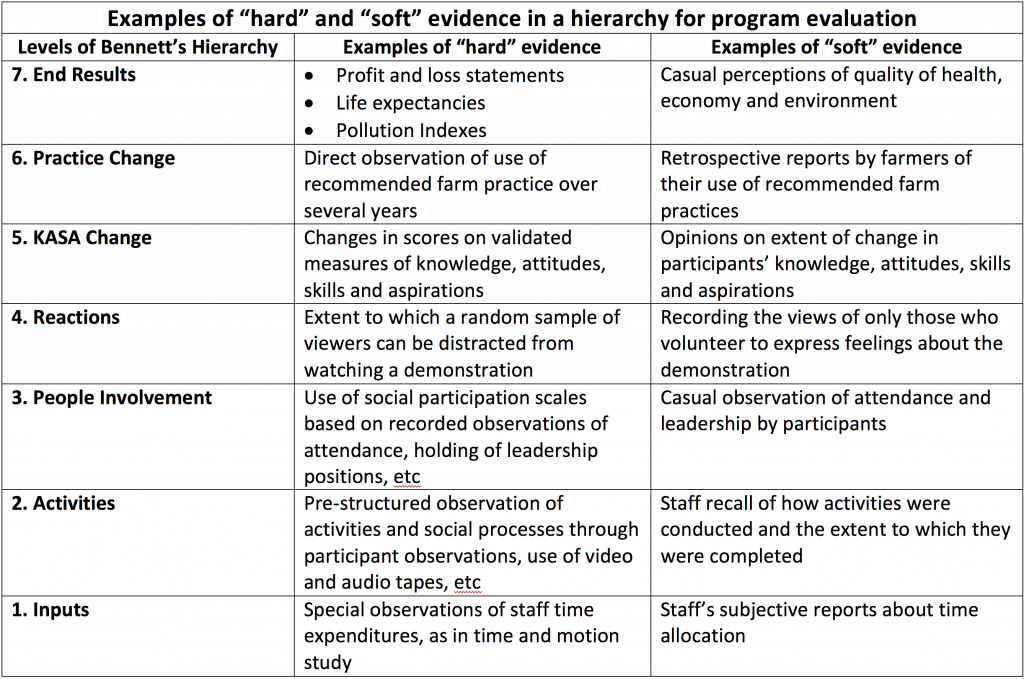Published – 16 November 2017 By Gavin Beever
The model is based on seven categories for planning and evaluating extension programs. The categories are linked in a logical “chain of events”. It starts with inputs and goes through to the last two categories of practice change and end results. The model has been tried and tested for over 40 years.
With the emphasis being on practice change and end results for many extension program funders in Australia today; Bennett’s Hierarchy is still an extremely useful model for Extension Professionals to use.
KASA, is a term familiar to many extension agents and is a key category in the hierarchy. It stands for changes in participant’s knowledge, attitudes, skills and aspirations. Bennett proposes that when participants apply their KASA, this leads to practice change and from practice change comes end results.
Evidence of an extension program reaching it’s objectives can be gathered and mapped against Bennett’s Hierarchy. Bennett stated that: “Evidence of program impact becomes stronger as the hierarchy is ascended” (Bennett, 1975).

A Guide to Using Bennett’s Hierarchy for Evaluation
Step 1. Document the Extension Program’s objectives and proposed outcomes. Where possible use the S.M.A.R.T. principle; are they specific, measurable, achievable, realistic and time bound
Step 2. Identify who the project stakeholders are
Step 3. Be clear on who is the audience for the evaluation report
Step 4. Develop a problem statement for the evaluation that clearly articulates what the evaluation is hoping to achieve
Step 5. Write the scope for the evaluation. This describes what the evaluation will be covering and how it will be delivered
Step 6. Select the levels of Bennett’s Hierarchy to be assessed and the quality of the evidence that is required: Document the information needs (evidence) for the evaluation for each level that is required to be covered in order to assess whether the program has met it’s objectives. Quantitative (“hard”) data and Qualitative (“soft”) data will both be required. Evidence of “end results” is the strongest evidence for the extension program having met it’s objectives.
“When you select evidence for evaluating Extension programs, ask these questions:
- Which levels of the hierarchy contain the kinds of evidence we need to make decisions?
- How “hard” does the evidence need to be?
- Are resources available to obtain the level and hardness of evidence needed?
- If resources are insufficient to provide the level and hardness of evidence desired by decision makers: (i) Will decision makers be able to use a lower level of evidence, or softer evidence. If not, (ii) Can you get more resources” – Claude Bennett (1975)
Step 7. Identify the research styles, roles and methods that will be used to gather the required information for each level of Bennett’s Hierarchy that the evaluation is aimed at covering. Example research styles are shown below:
-
- Complete observer – records and is “unseen”
- Observer as participant – knows and owns the role of participant and observer and is an active collaborator in the research
- Participant as observer – is a participant first and then is requested to observe/record
- Complete participant – does not have a “research” role but notes and observations are recorded as to their participation
As Claude Bennett pointed out “Extension program evaluation isn’t an end in itself. It’s worth doing only if it helps in making decisions about program continuation, priorities, modifications, and so on.”

Content sources and further information
Bennett, C (1975) Up the hierarchy. Journal of Extension. [On-line], 13(2).
